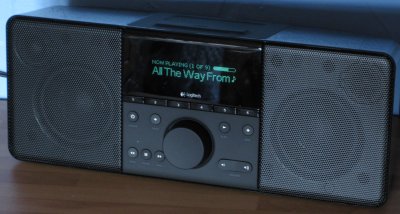
Logitech’s Squeezebox Boom sounds remarkably good, unexpectedly so for a small plastic unit. There is clarity; there is bass; there is presence; piano sounds like piano; it makes music. This is less surprising when you read the paper on its audio design [pdf]:
Section C shows the design of Squeezebox Boom. Four separate speakers, four separate amplifiers, and six DACs all digitally controlled with a high powered DSP provide the ultimate in acoustic signal integrity and can produce great sound through the entire audio spectrum. Without a subwoofer, the Squeezebox boom goes from a -3 dB response at 50 Hz (at low volume settings) to about 85 Hz (at high volume settings), all the way to 20 kHz. With the addition of a subwoofer, the entire audio band, from 20 Hz to 20 kHz, is covered.
Four speakers means two drivers for each channel, one for the mid-range and bass, and a tweeter for high frequencies. But why six DACs (Digital to Analog Converters)? It is all to do with the crossover, the electronics that divides the signal so that the high frequencies go to the tweeter, and the rest to the main driver. This is a weak point in many speaker systems. The most common arrangement is a small analog board inside the speaker cabinet, which is convenient because it lets you connect a full-range signal to the speaker. By contrast, the Boom’s crossover is in the digital domain. Four digital signals emerge from a DSP (Digital Signal Processor), each of which gets its own DAC, creating an analog signal that is then amplified and sent to the speaker drivers. The other two DACs are dual-purpose, generating either the left and right channel of a headphone/line out port, or a signal for an external subwoofer.
The DSP is more than just a digital crossover. At low volume, when the speakers are operating well within their physical limitations, the DSP boosts the low frequencies to achieve extended bass. It is a similar idea to the old-fashioned “loudness” control on some amplifiers, but better executed, thanks to the 48-by-24-bit DSP, active amplification, and prior knowledge of the speakers being driven.
The outcome is great sound. Not as good as a typical hi-fi separates system; but a lot better than most boom boxes. It goes reasonably loud too, thanks to highly efficient Class D amplifiers. Ideal as an upmarket bedside clock radio, or for the kitchen or study.
CDs not accepted here
The Squeezebox Boom is not a CD player, nor is it a radio. It is a network music player, which means that it plays digital streams sourced either on a local media server, or on the Internet. In order to make it work, you need a home network, wired or most likely wireless, and either a broadband Internet connection, or a music server, or both.
Here’s a quick look at how it works. Open the box, and this is what you find:
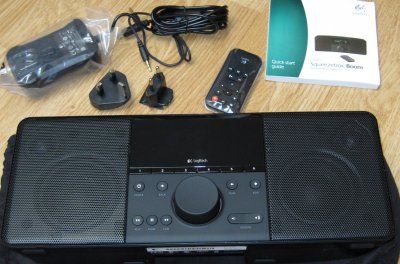
OK, so we have the Boom, a power adaptor, a remote, a mini-jack cable for attaching an iPod or MP3 player, and a 27-page Quick Start manual.
Let’s assume that you have broadband Internet and home wi-fi. Plug in the Boom, turn on, and it will likely connect to the network automatically, subject to your entering a code for your WEP or WPA wireless security. Now what?
This is where it begins to fall apart. Don’t get me wrong; the Squeezebox networked audio system is fantastic, the best I’ve come across. Unfortunately it is not particularly easy or intutive to set up. The Quick Start manual suggests that you set up an account with SqueezeNetwork, an internet music service run by Logitech which aggregates a number of other services including Last.fm, MP3tunes, RadioTime and RadioIO. Some services require a subscription, others are free. The manual adds that you may want to download and install SqueezeCenter, a music server which runs on a local PC or NAS (Network Attached Storage), though it says this is optional.
In truth, if you want the best from the Squeezebox Boom, running SqueezeCenter is a necessity. That may change: arguably it is Internet streaming, rather than local streaming, that is the future for this kind of device. Last week Logitech added Napster support to SqueezeCenter, which lets subscribers play any track from Napster’s huge library on demand. I tried this and it works well. Right now there is also clamour for a Spotify plug-in, which would also enable a wide choice of tracks direct from the Net.
That said, the difference in sound quality between Napster at 128 Kbps, or Spotify at 160kbps, compared to lossless Flac from SqueezeCenter is very noticeable. Arguably even the Boom is unnecessarily good for this purpose. Further, SqueezeCenter opens up so many Squeezebox features that you will not want to do without it.
Geek’s paradise
Now, SqueezeCenter is a geek’s paradise. The software is open source, written in Perl, and extensible with a large number of plug-ins. Again, I highly recommend it; but if you like plug-and-play simplicity it might not appeal.
If you want the best experience, the solution is to download and install SqueezeCenter on a device that is always available. This could be a NAS like Netgear’s ReadyNAS; or a PC running Windows Home Server; or a PC running Linux; or a Mac Mini, or any computer that has plenty of storage and that you are happy to leave always on. Next, rip your CDs to a high quality format like lossless FLAC, or ALAC via iTunes, or 320bps MP3, or any format that Squeezebox supports, and configure SqueezeCenter to use the location of your music as its source. Alternatively, you can use downloaded music provided that it is not DRM-protected.
Make sure the music files are well tagged. Tags are metadata embedded into each file. At a minimum, these include the name of the track, the album, and the artist. I’ve found it helpful to populate the Album Artist field, as this is used by the Squeezebox index. It is also worth taking care that the tagging is consistent; if you have albums by Katy Perry, K Perry, and Perry, K, then as far as Squeezebox is concerned these are three different artists.
At this point, I’m going to assume that you have SqueezeCenter installed along with some music to play and a valid SqueezeNetwork login. I’m not pretending that it is always easy to get to this point; but as with all the best open source things, there is plentiful help available.
Controlling Squeezebox Boom
There are three ways to control the Boom. You can use the front panel, a remote, or a web browser. Here’s a quick look at each.
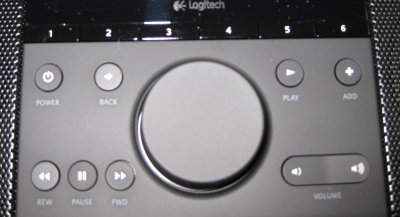
The front panel has 6 numbered presets, power on, a large knob, a back button, a rocker volume control, and buttons for play/pause/fast wind. There’s also a Sleep button on top of the unit.
The Squeezebox is driven by a hierarchical menu. The knob is dual-purpose; if music is playing it is a volume control, or otherwise it scrolls through menu options at the current level. Pressing the knob selects the current item, possibly activating a sub-menu. Pressing back takes you up to the previous menu level. The presets select and play six favourite items. For example, if you like BBC radio you could set the presets to BBC radio 1 – 6 and have one-click access to BBC stations, just like an old-fashioned radio. A neat touch is that you can pause live radio for a minute or two without missing anything; the Boom will buffer the stream for you.
But how do you play music? Let’s say I want to play Sade’s album Diamond Life. I press Power to switch from the screen saver (by default a clock) to the top-level menu. I spin the knob to Music Library and press. I spin again to Albums and press. I spin again to Diamond Life and press. Finally, I press Play. You can also press the Plus (+) key which adds the result to the current playlist, meaning that it gets played after whatever is currently playing.
If you have thousands of albums scrolling through all of them is tedious, so try a search. After Music Library, spin to Search. You can search by Albums, Artists or Songs. Spin to Albums and press. The display shows the letter A. You have to spell out your search by spinning to the letter you want and pressing to select it. Search is incremental and ignores spaces, so in this example just DIA would be fine. Press. If there is more than one match, spin through the results, press to select, and press play.
A bit painful? In practice it is not too bad; but it gets tiresome if you have a large collection. There are several strategies to make it easier. Presuming you like all your music, you can choose Music Library – Random Mix, which is a shuffle of everything. Or you can add your top albums to a Favourites menu. Or you can make playlists of selected albums or tracks, and select them from the Playlist menu, or add the playlists to Favourites. Alternatively, you can control the Boom with something other than the front panel.
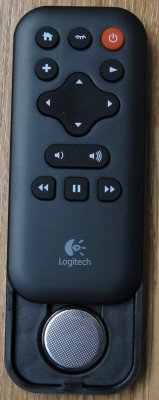 The remote is a compact item with a standard coin-size battery. The controls are similar but not identical to those on the panel. Home is a useful additional button that takes you to the top menu. The eyebrow button is Sleep. The central joystick combines the functions of the knob and the back button; generally it is more intuitive. No presets though.
The remote is a compact item with a standard coin-size battery. The controls are similar but not identical to those on the panel. Home is a useful additional button that takes you to the top menu. The eyebrow button is Sleep. The central joystick combines the functions of the knob and the back button; generally it is more intuitive. No presets though.
A thoughtful extra is that the remote is magnetic, and will stick to a fridge door or in a recess on top of the Boom.
It’s worth noting that the remote which comes with the standard Logitech Squeezebox has more buttons, and is compatible with the Boom. Additional buttons on the full remote include alpha-numeric keys, search, favourites, browse, shuffle, repeat, display size and brightness. Logitech went a little too far in stripping the mini-remote to the bare minimum.
An even better remote is available, at a price. The Squeezebox Controller is a true interactive remote that connects to the wireless network. Instead of squinting at the Boom display from a distance, you can read the colour screen on the remote itself.
Control from a web browser or device
For full control over a Squeezebox, you can’t beat a web browser, particularly if a keyboard is attached. Scrolling with a mouse is quicker and easier, search is fast, and you have access to all the settings of your player and system. These are very extensive. For example, you adjust the way search works, the information displayed on the panel, whether to have fade affects when the song changes, and the configuration and availability of plugins. Until you have explored Squeezecenter, you will not fully appreciate what a Squeezebox can do.
One idea is to use the browser on a small device like a Smartphone, Nokia internet tablet, Netbook or iPod Touch. There are skins availble that make Squeezecenter work well on small screens. If you have a suitable device, you can also download custom applications that call the Squeezecenter API to control it.
Multi-room control
One of the best Squeezebox features is that each player is independently controlled. Once you have taken the step of putting Squeezecenter on the network, you can have a Squeezebox in the living room, another in the kitchen, and another in the study, and have them all playing different music. You can also specify that players are synchronized, so they all play the same. The web browser interface lets you control any player, which means you can give someone else in the house a shock if you are mischievously inclined.
Connecting a sub-woofer
I tried the Boom with a Rel Quake sub-woofer. There was no shortage of bass; but the combined system was less impressive than I had expected. It may be that adding a sub-woofer detracts from the careful optimization you get with the internal speakers.
Connecting an iPod
The Boom sounds good with an Ipod connected, better than most iPod speaker systems (as it should, considering the price). My impression though was that the sound was inferior to that from a Squeezecenter. The signal passes through a DAC in the iPod, then an ADC (Analog to Digital Converter) in the Boom, then through the Boom’s DSP, then through a DAC for output, and it’s possible that the extra conversion steps are detrimental to the sound quality.
Squeezebox Boom pros and cons
The Boom is an amazing device and far better than the average clock radio or CD boom box. Then again, it is more expensive than most. It reminds me of Apple’s iPod hi-fi, introduced with fanfare in 2006, and quietly withdrawn in 2007. Apple created a boom box with audiophile pretensions, and found that the mass market did not care much about the value this added. Logitech may be making the same mistake with the Boom, though it will be content with a smaller market than would satisfy Apple.
The other problem with the Boom is that setting up Squeezecenter and puzzling out the controls is not as simple as it should be. It would not last five minutes in Apple’s usability labs. It’s also a shame that Logitech is not participating in the DLNA (Digital Living Network Alliance), which promotes interoperability between networked media servers and devices. The problem is mitigated by the open source software and community around Squeezecenter.
Once set up and figured out, a Squeezebox Boom delivers great value.
Check price and availability at Amazon.com
Check price and availability at Amazon.co.uk
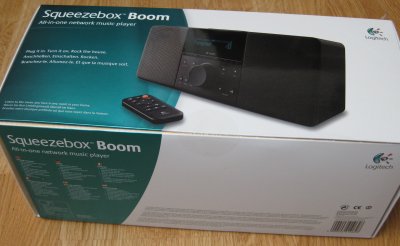
Summary
Good points
- Excellent sound quality
- Flexibility: internet radio, podcasts, local media server
- Thoughtful touches like magnetic remote
- Play Napster’s entire library if you subscribe
Bad points
- Controls can be baffling at first
- Needs always-on media server for best results
- Complex setup
Note: Some corrections added in response to comments on the Squeezebox forum.
Excellent review – really spells out the pros and cons of the Squeezebox ‘experience’.
Despite the complexity of getting it all set up I would recommend the system to anyone with a bit of tech-savvy. Probably a bit too involved for run of the mill consumers though.
Excellent review.
Question as to how you connected the REL sub.
As you know, REL recommends connecting via the high-level inputs outputs via the Neutrik Speakon High Level Leads. Did you somehow connect these leads to the Headphone out?
Or did you connect via the Sub out?
@ljb I used the sub out. Otherwise, it would not really test the Boom’s sub support. But you are right about REL’s recommendation; I would be interested to hear it with alternative subs.
Tim
I’m just a bit baffled by the apparent “complexity.” I find it exceedingly easy to setup. I was already running Squeezecenter, but even that is easy. You point to a directory and let it run. It only becomes more complex if you’re looking for more complex features, and I still find that whether simple. My friend can’t even get FLAC files to import correctly into their Macbook’s iTunes–now that’s complex. Apple Labs or not.
I am obviously not techy enough to set mine up! I have fallen at the first hurdle as I cannot work out how to input the sewcurity code for my wireless network into the Boom.
Any help would be appreciated as this was a father’s day present and as yet still sitting quiet!
Thanks in advance of some assistance.
@David:
Setting it up: It only accepts a “HEX” security code. So if your network is set up with an ASCII one (i.e. normal alphanumeric letters and numbers), you’ll need to convert this to the hexadecimal codes it asks for. You can do this online: http://www.wifizard.com/wi-fi/convert.htm
Depending on the length of your password, you’ll need to pick the 64/128/etc. option.
Great review, shame I bought mine over the weekend and waded through the complexities of the user interfaces before I read it.
Just sent back a Sony Giga Juke (faulty network components) to make way for the BOOM and got to say it knocks the socks of it in every respect.
Hi – can anyone answer this:
My wife and I share a Windows XP computer, each with our own login and itunes account. When I set up my Squeezebox, I was logged in as myself, and the Box properly used my iTunes account as the input source. We’d like to have my wife’s account as an alternative source. Any thoughts?
@Paul sorry I don’t use iTunes at all, maybe someone else can help? Worth trying the Squeezebox forum too.
Tim
You will probably have problems setting up on a Mac because of its increased security. Call up support and get the info on how to set up for Mac sent to you. If you are lucky they will break policy and teach you what to do on the phone. After set-up the best way to hear music is with a $5 subscription to Napster. Unfortunately the interface for Napster sucks and trying to find the good music you know little about like the Boo Radleys or that one Stereolab or world or what are the oldies/90s you want in your random song list is not going to come because obviously they have playlists just to look like a real site not to support finding music. So you are going to have to search the web for where this info really exists. It is out there but buried with all the generic info on music. Unfortunately for whatever reason the acoustics in my room are horrible and I can’t hear how it should sound. I say unfortunately because the room is tiny. But having said that if you aren’t satisfied with the sound hook it up to good speakers/tuner and you are ready to go. Napster is missing a few things but with all it offers plus 60 free MP3s to get the 30 second tracks it is more than generous. Where is Trout Fish Replica and others but you know why complain with this much music that comes at this clear a signal. I miss albums but the upside is almost no wires or things to keep like the albums and exposure to new great stuff. THen you can get talk, documentaries and so on for your radio stations.
$60 a month will give you almost unlimited music and right now the Boos sound cool- I didn’t know that the Foo FIghters ripped them off. I’m going to have to search for the lyrics though. So really the only problem with Napster is that now there is so much music, so much politics on who gets noticed and so much bad stuff blocking out the great stuff- which is there but so so hard to find and worse remember. The next trick is to get a collection going from Netflix for my videos to go along with my Comic Book collections and Novels. I will start with Breaking Bad. But the point is why pay for Itunes and album only when you can easily set up entire albums onto your boom in under a minute an album. Do we really need to take our music everywhere we go or to always tune out the world typing on our text machine. I would say no but apparently this is the key because I’m in the worst city in America for white males to date and get married and the Ys who are typing and don’t talk and follow the chicks like a dog while they tell them what to do at the grocery store and so on are way ahead of me. Maybe things will change when i start texting all the time on the freeway while pumping the Boo Radleys. And I stop looking up or talking to people and I just follow like a dog.
Did I say month, I meant $60 a year. I don’t believe in question marks either.
I notice in the picture that the unit comes with US and UK (3 pin) power supply adapters.
Did you get this unit in the US.
I’m going to the US soon and would love to pick one up if I can use it in UK/Ireland.
@Bernard I wouldn’t count on it, there might be differences between regions, but you can get adaptors. Best to check before purchase.
Tim